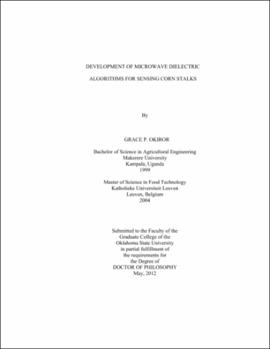| dc.contributor.advisor | Jones, Carol L. | |
| dc.contributor.author | Okiror, Grace P. | |
| dc.date.accessioned | 2013-11-26T07:43:15Z | |
| dc.date.available | 2013-11-26T07:43:15Z | |
| dc.date.issued | 2012-05 | |
| dc.identifier.uri | https://hdl.handle.net/11244/6420 | |
| dc.description.abstract | Scope and Method of Study: | |
| dc.description.abstract | The scope of this work involved a feasibility investigation of the potential of using free-space microwave scattering parameters for sensing corn stalks in the field. Testing began with theoretical simulations of scattering using dielectric rods as a first order model, followed by actual measurements of these rods. During the second phase, the microwave power attenuation, phase shift, and return loss of actual corn stalks during growth and development were measured at the laboratory scale, along with the diameters and moisture content. Finally, statistical analysis of all the data obtained was conducted to derive useful patterns and recommendations for subsequent research. | |
| dc.description.abstract | Findings and Conclusions: | |
| dc.description.abstract | The results obtained have demonstrated close agreement between simulations and measurements for attenuation and return loss in relationship with the diameter of the dielectric rods, within the same frequency range. A frequency offset was observed for the relative attenuation peaks, but the patterns of the physical values, slopes and coefficients of determination were maintained. This offset requires closer investigation. It is concluded that the finite difference time domain method provides reasonably accurate simulations of free-space scattering parameters of small, finite dielectric rods, such as corn stalks. The patterns obtained showed strong regression relationships between 1 - 10 GHz, which should be the focus of future studies. Despite the apparent numerical discrepancies, a potential indeed exists in using scattering parameters to predict diameters of biological products for agricultural applications. | |
| dc.description.abstract | The measurement of the dielectric properties of corn stalks revealed some interesting relationships with diameter and moisture content. All the scattering parameters displayed a similar pattern for the whole and stripped stalks. Whole stalks consistently showed regression coefficient peaks at lower frequencies (1 - 3 GHz). This indicates that both bistatic and monostatic scattering systems can be developed that operate within this frequency range for nondestructive sensing of corn stalks in the field. | |
| dc.format | application/pdf | |
| dc.language | en_US | |
| dc.rights | Copyright is held by the author who has granted the Oklahoma State University Library the non-exclusive right to share this material in its institutional repository. Contact Digital Library Services at lib-dls@okstate.edu or 405-744-9161 for the permission policy on the use, reproduction or distribution of this material. | |
| dc.title | Development of microwave dielectric algorithms for sensing corn stalks | |
| dc.contributor.committeeMember | Weckler, Paul R. | |
| dc.contributor.committeeMember | Wang, Ning | |
| dc.contributor.committeeMember | Stone, Marvin | |
| dc.contributor.committeeMember | Maness, Niels O. | |
| osu.filename | Okiror_okstate_0664D_12125.pdf | |
| osu.accesstype | Open Access | |
| dc.type.genre | Dissertation | |
| dc.type.material | Text | |
| dc.subject.keywords | agriculture engineering | |
| thesis.degree.discipline | Biosystems and Agricultural Engineering | |
| thesis.degree.grantor | Oklahoma State University | |
